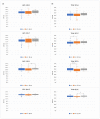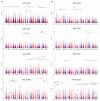GWAS in a Collection of Bulgarian Old and Modern Bread Wheat Accessions Uncovers Novel Genomic Loci for Grain Protein Content and Thousand Kernel Weight
- PMID: 38674493
- PMCID: PMC11054703
- DOI: 10.3390/plants13081084
GWAS in a Collection of Bulgarian Old and Modern Bread Wheat Accessions Uncovers Novel Genomic Loci for Grain Protein Content and Thousand Kernel Weight
Abstract
Genetic enhancement of grain production and quality is a priority in wheat breeding projects. In this study, we assessed two key agronomic traits-grain protein content (GPC) and thousand kernel weight (TKW)-across 179 Bulgarian contemporary and historic varieties and landraces across three growing seasons. Significant phenotypic variation existed for both traits among genotypes and seasons, and no discernible difference was evident between the old and modern accessions. To understand the genetic basis of the traits, we conducted a genome-wide association study with MLM using phenotypic data from the crop seasons, best linear unbiased estimators, and genotypic data from the 25K Infinium iSelect array. As a result, we detected 16 quantitative trait nucleotides (QTNs) associated with GPC and 15 associated with TKW, all of which passed the false discovery rate threshold. Seven loci favorably influenced GPC, resulting in an increase of 1.4% to 8.1%, while four loci had a positive impact on TKW with increases ranging from 1.9% to 8.4%. While some loci confirmed previously published associations, four QTNs linked to GPC on chromosomes 2A, 7A, and 7B, as well as two QTNs related to TKW on chromosomes 1B and 6A, may represent novel associations. Annotations for proteins involved in the senescence-associated nutrient remobilization and in the following buildup of resources required for seed germination have been found for selected putative candidate genes. These include genes coding for storage proteins, cysteine proteases, cellulose-synthase, alpha-amylase, transcriptional regulators, and F-box and RWP-RK family proteins. Our findings highlight promising genomic regions for targeted breeding programs aimed at improving grain yield and protein content.
Keywords: TKW; Triticum aestivum L.; association mapping; candidate genes; grain protein content; grain quality; grain yield.
Conflict of interest statement
The authors declare no conflicts of interest. The funders had no role in the design of this study; in the collection, analyses, or interpretation of data; in the writing of the manuscript; or in the decision to publish the results.
Figures




Similar articles
-
Exploring Novel Genomic Loci and Candidate Genes Associated with Plant Height in Bulgarian Bread Wheat via Multi-Model GWAS.Plants (Basel). 2024 Oct 3;13(19):2775. doi: 10.3390/plants13192775. Plants (Basel). 2024. PMID: 39409644 Free PMC article.
-
Multi-locus genome-wide association mapping for major agronomic and yield-related traits in sorghum (Sorghum bicolor (L.) moench) landraces.BMC Genomics. 2025 Mar 28;26(1):304. doi: 10.1186/s12864-025-11458-4. BMC Genomics. 2025. PMID: 40155810 Free PMC article.
-
Analysis of genetic diversity and genome-wide association study for drought tolerance related traits in Iranian bread wheat.BMC Plant Biol. 2023 Sep 15;23(1):431. doi: 10.1186/s12870-023-04416-3. BMC Plant Biol. 2023. PMID: 37715130 Free PMC article.
-
Genetic Variation for Protein Content and Yield-Related Traits in a Durum Population Derived From an Inter-Specific Cross Between Hexaploid and Tetraploid Wheat Cultivars.Front Plant Sci. 2019 Nov 22;10:1509. doi: 10.3389/fpls.2019.01509. eCollection 2019. Front Plant Sci. 2019. PMID: 31824537 Free PMC article.
-
Genetic dissection of grain architecture-related traits in a winter wheat population.BMC Plant Biol. 2021 Sep 10;21(1):417. doi: 10.1186/s12870-021-03183-3. BMC Plant Biol. 2021. PMID: 34507551 Free PMC article.
Cited by
-
Markers Associated with Starch, Protein and Asparagine Content in Grain of Common Wheat.Genes (Basel). 2025 May 29;16(6):661. doi: 10.3390/genes16060661. Genes (Basel). 2025. PMID: 40565553 Free PMC article.
-
Exploring Novel Genomic Loci and Candidate Genes Associated with Plant Height in Bulgarian Bread Wheat via Multi-Model GWAS.Plants (Basel). 2024 Oct 3;13(19):2775. doi: 10.3390/plants13192775. Plants (Basel). 2024. PMID: 39409644 Free PMC article.
References
-
- Peña R.J. Wheat for Bread and Other Foods. In: Curtis B.S., Rajaram S., Gómez Macpherson H., editors. Bread Wheat. Improvement and Production. Food and Agriculture Organization of the United Nations; Rome, Italy: 2002. [(accessed on 10 December 2023)]. (FAO Plant Production and Protection Series No. 30). Available online: https://www.fao.org/3/y4011e/y4011e0w.htm#bm32.
-
- Cooper M., Woodruff D.R., Philips I.G., Basford K.E., Gilmour A.R. Genotype-by-management interactions for grain yield and grain protein concentration of wheat. Field Crops Res. 2001;70:87–88. doi: 10.1016/S0378-4290(01)00134-4. - DOI
Grants and funding
LinkOut - more resources
Full Text Sources
Research Materials

